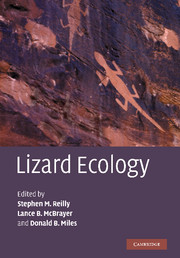Book contents
- Frontmatter
- Contents
- List of contributors
- Preface
- Historical introduction: on widely foraging for Kalahari lizards
- I Organismal patterns of variation with foraging mode
- II Environmental influences on foraging mode
- 12 The foraging biology of the Gekkota: life in the middle
- 13 Foraging mode in the African cordylids and plasticity of foraging behavior in Platysaurus broadleyi
- 14 Interactions between habitat use, behavior, and the trophic niche of lacertid lizards
- 15 Food acquisition modes and habitat use in lizards: questions from an integrative perspective
- 16 The evolution of foraging behavior in the Galápagos marine iguana: natural and sexual selection on body size drives ecological, morphological, and behavioral specialization
- 17 The evolution of the foraging mode paradigm in lizard ecology
- Index
- References
17 - The evolution of the foraging mode paradigm in lizard ecology
Published online by Cambridge University Press: 04 August 2010
- Frontmatter
- Contents
- List of contributors
- Preface
- Historical introduction: on widely foraging for Kalahari lizards
- I Organismal patterns of variation with foraging mode
- II Environmental influences on foraging mode
- 12 The foraging biology of the Gekkota: life in the middle
- 13 Foraging mode in the African cordylids and plasticity of foraging behavior in Platysaurus broadleyi
- 14 Interactions between habitat use, behavior, and the trophic niche of lacertid lizards
- 15 Food acquisition modes and habitat use in lizards: questions from an integrative perspective
- 16 The evolution of foraging behavior in the Galápagos marine iguana: natural and sexual selection on body size drives ecological, morphological, and behavioral specialization
- 17 The evolution of the foraging mode paradigm in lizard ecology
- Index
- References
Summary
Always question the paradigm
Carl Gans, 1986Sometimes a straightforward natural history observation initiates the development of a major area of research in ecology or evolutionary biology. The observation that species numbers increase with island area is one such example. Another is the description by Pianka (1966) and Schoener (1969) of two “distinct” behavioral morphs that differed in their feeding behavior forty years ago. Although other studies described the behavior (see, for example, Kennedy, 1956; Rand, 1967), it was the early publications of Pianka and Schoener that demonstrated the ecological significance of the search strategies. Ostensibly a species' movement behavior affected its foraging success and consequently was a potential mechanism for resource partitioning. Hence, understanding variation in foraging mode was a foundation for key papers in theoretical and empirical analyses of species interactions (Schoener, 1971). However, ecologists quickly realized the numerous ramifications inherent in the differences between species that ambush prey vs. those that widely search an environment for elusive or concealed prey (see, for example, Eckhardt, 1979).
In a seminal paper, Huey and Pianka (1981) formalized the foraging mode paradigm. Their study elaborated on the potential ecological consequences of variation in search behavior and presented a summary of the traits that were expected to be affected by foraging mode. Using data collected from Kalahari lizards, they corroborated several of the hypothesized differences between ambush and widely foraging lizards. One may ask why their publication was so important.
- Type
- Chapter
- Information
- Lizard Ecology , pp. 508 - 521Publisher: Cambridge University PressPrint publication year: 2007
References
- 6
- Cited by

